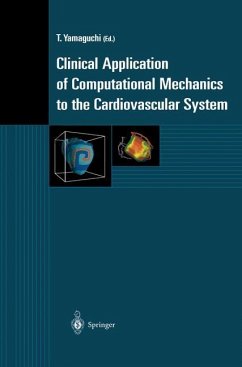The term "computational biomechanics" describes the approach taken in a 3-year project promoted by the National Cardiovascular Center of Japan to integrate fluid and solid mechanics in studies of the heart and vascular system. The goal was to create a new, comprehensive methodology in cardiovascular research, including both radiological and electrophysiological studies to achieve the most comprehensive view. This book compiles reports of the work conducted by leading researchers in biomechanics using a full array of cutting-edge technology - from the supercomputer in the National Cardiovascular Center to individual PCs. The book stresses application rather than development of theory, thus appealing to a wide audience ranging from researchers without extensive backgrounds in computation, to graduate students and clinical practitioners. Enhanced with color illustrations, the book is a valuable resource in biomedical engineering.
Vascular diseases, particularly atherosclerosis, are the most frequent and critical underlying fatal disorders in the industrialized world. Cardiovascular deaths are the leading cause of death in the Western world. Although cancer or malignant neoplasms recently have topped the list of causes of deaths in Japan, cardiovascular and cerebrovascular diseases bring about more deaths than cancer if they are reclassified into a unified category of diseases of the vascular system. The National Cardiovascular Center was established by the Ministry of Health and Welfare of Japan to combat cardiovascular and cerebrovascular diseases. Since the Center was opened, we have continued to support basic and clinical sturlies of cardiovascular and cerebrovascular diseases within as weil as outside the Center. Clinical studies that we have supported in modern diagnostic and therapeutic measures against cardio- and cerebrovascular diseases have made remarkable advances in recent years, especially inmedical imaging technology including CT and MRI, and in interventional measures including balloon angioplasty and other catheter-based treatments. We are proud of the significant improvement in the overall survival rate and the quality of life of patients suffering from vascular disorders. However, there are still many essential difficulties remaining in the diagnosis and treatment of vascular disorders. Such difficulties necessitate further fundamental studies not only from the practical aspect but also from the integrated perspectives of medicine, biology, and engineering.
Vascular diseases, particularly atherosclerosis, are the most frequent and critical underlying fatal disorders in the industrialized world. Cardiovascular deaths are the leading cause of death in the Western world. Although cancer or malignant neoplasms recently have topped the list of causes of deaths in Japan, cardiovascular and cerebrovascular diseases bring about more deaths than cancer if they are reclassified into a unified category of diseases of the vascular system. The National Cardiovascular Center was established by the Ministry of Health and Welfare of Japan to combat cardiovascular and cerebrovascular diseases. Since the Center was opened, we have continued to support basic and clinical sturlies of cardiovascular and cerebrovascular diseases within as weil as outside the Center. Clinical studies that we have supported in modern diagnostic and therapeutic measures against cardio- and cerebrovascular diseases have made remarkable advances in recent years, especially inmedical imaging technology including CT and MRI, and in interventional measures including balloon angioplasty and other catheter-based treatments. We are proud of the significant improvement in the overall survival rate and the quality of life of patients suffering from vascular disorders. However, there are still many essential difficulties remaining in the diagnosis and treatment of vascular disorders. Such difficulties necessitate further fundamental studies not only from the practical aspect but also from the integrated perspectives of medicine, biology, and engineering.








